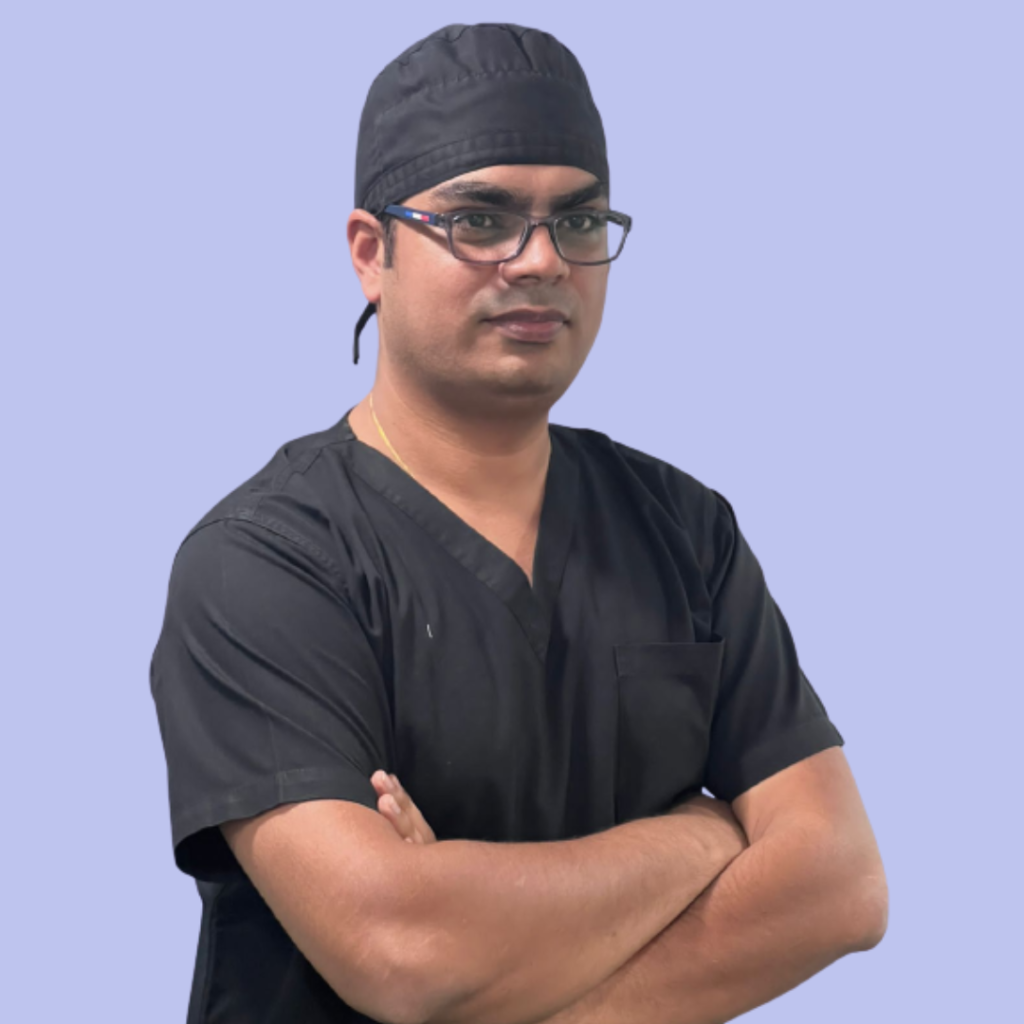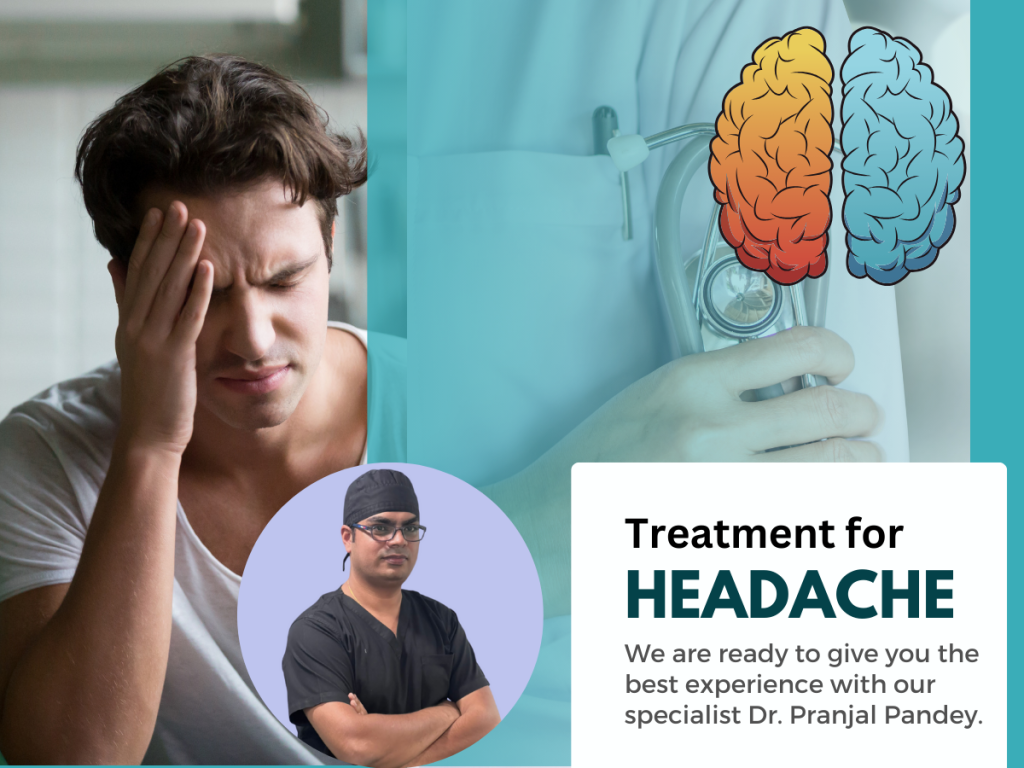Dr. Pranjal Pandey
MBBS, MS (General Surgery), M.Ch. Neurosurgery
A neurosurgeon with over 15 Yrs. years of experience
Awarded as the best resident in Neurosurgery and was a regional & zonal winner at TYSA neurosurgery
Contact Details
ADDRESS: J-203, Basement, Block J, Saket, New Delhi, Delhi 110017, India
PHONE: +91-8800924351
EMAIL: info@drpranjal.com
WORKING DAYS/HOURS: Mon-Sun: 9:00 AM - 8:00 PM

Most people will suffer from head pain frequently throughout their lives. If you are feeling pain on either side of the head or suffering from pain in the forehead or upto the nape of neck in the back then it could be concluded as a headache. Though many different kinds of headaches exist, tension headaches are the most prevalent. Although most headaches are not harmful, some may indicate a significant underlying illness.

Overview
What is a headache?
A headache is a type of head or face discomfort frequently characterized as a dull, acute, throbbing pressure. A headache’s kind, intensity, location, and frequency might vary substantially. Sites of headaches include the area between the nape of the neck and upto the eyes in front.
Most people will suffer from headaches frequently throughout their lives. They are the most prevalent type of discomfort and are commonly used as an excuse for missing work, school days. and It is one of the most common complaints for which a patient may seek consult with a headache specialist doctor appointments.
Although most headaches are not harmful, some may indicate a more severe illness.
What are the types of headaches?
1. Primary Headaches
2. Secondary Headaches
Primary headaches
When the pain-sensitive receptors in the head malfunctions and some pain is being felt in the head, such head pains are known as primary headaches. They are neither brought on by nor a sign of any underlying medical issues. Specific individuals may be genetically predisposed to primary headaches.
Primary headache types include:
1. Tension-Type Headaches
2. Migraines
3. Headaches in clusters
4. New daily persistent headaches (NDPH)
Certain conditions or elements of one’s lifestyle might cause some primary headaches, such as:
1. Alcoholic beverages, especially red wine.
2. Some foods, such as processed meats with added nitrates (can cause food-induced headaches).
3. Nicotine consumption (nicotine headache).
4. Sleep patterns shifting or ceasing to sleep.
5. Poor posture.
6. Exercise and other physical activities (exertion headaches).
7. Skipped meals due to a headache or hunger.
8. Sneezing, coughing, blowing your nose, straining (as when passing gas), or laughing or crying.
Secondary headaches
An underlying medical problem brings on secondary headaches. They are seen as an indication or symptom of a disease.
Some secondary headache types that go away when the primary ailment is addressed and aren’t always harmful are:
1. Dehydration.
2. Sinuses.
3. Excessive drug usage.
The following types of secondary headaches may indicate a serious or maybe fatal illness:
1. Spinal headaches:
Usually following a spinal tap, spinal headaches are severe headaches caused by spinal fluid seeping out of the membrane encasing your spinal cord. The majority of spinal headaches are manageable at home, but if left untreated for an extended period, they can result in potentially fatal consequences such as seizures and subdural hemorrhage.
2. Thunderclap headaches:
Headaches that strike abruptly and with great agony, like thunderclaps, are known as thunderclap headaches. This kind of headache lasts at least five minutes and reaches its peak discomfort in just one minute. In thunderclap headaches, getting medical help is crucial. Underlying causes of thunderclap headaches may indicate:
a. Aneurysmal or spontaneous subarachnoid haemorrhage
b. Ruptured arterio venous malformations
c. Intracranial Haemorrhage due to hypertension
d. Syndrome of reversible cerebral vasoconstriction.
What distinguishes a migraine from a headache?
Migraine is one of a kind of primary headache problem.
A frequent neurological disorder called migraine is characterized by a pounding headache usually on one side of the brain, may or may not be accompanied by aura among other symptoms.
Who is affected by headaches?
Headaches can affect children, adolescents, and adults alike. 96% of individuals report having had a headache at some point.
Tension-type headaches affect roughly 40% of individuals worldwide, while migraine headaches affect about 10% of people.
Signs and Origins
What is a headache’s primary cause?
A headache cure is usually possible only after knowing its cause. A headache is caused by several processes that trigger specific neurons that influence blood vessels and muscles. Your brain receives pain signals from these nerves, which results in headaches.
Do headaches run in families?
Migraine, which are a kind of headache, have some are genetic predisposition. Most children who suffer from migraines also often have at least one biological parent who does.
Diagnosis and Tests
How are headaches evaluated and diagnosed by Dr. Pranjal Pandey?
Speak with Dr. Pranjal Pandey, a headache specialist in Delhi if you get severe or frequent headaches, you can reach out to him out immediately.
It’s critical to accurately identify the type of headaches so Dr. Pranjal Pandey diagnose the cause properly and provides effective treatment for headaches to make you feel better. In addition to performing a physical examination and discussing your headache symptoms, he will also review your medical history. This discussion is a component of a headache assessment.
Your headache can be diagnosed more precisely by Dr. Pandey if you are aware of the following:
1. The moment the headache appeared.
2. Whether the headaches are of one kind or several different kinds.
3. What are the aggravating or relieving factors of the headache If engaging in physical exercise makes your headache worse.
4. Heredity: Who else in your family suffers from headaches?
5. Which, If any symptoms manifest in between headaches.
He may conduct physical and neurological exams following the completion of the medical history portion of the evaluation. Symptoms of headache or associated with headache include:
1. Fever.
2. Infection.
3. High blood pressure.
4. Muscle weakness, numbness or tingling.
5. Excessive fatigue.
6. Loss of consciousness.
7. Balance problems and frequent falls.
8. Vision problems (blurry vision, double vision, blind spots).
9. Mental confusion or personality changes.
10. Seizures.
11. Dizziness.
12. Nausea and vomiting.
What tests will be done to diagnose headaches?
To deal with headaches you will need headache remedies, which can be taken after going through certain tests. Scanners and other imaging tests help rule out other conditions but do not help diagnose migraines, cluster headaches, or tension headaches.
However, your headache specialist doctor Dr. Pranjal Pandey could perform a few imaging tests if he believes that another medical problem is the source of your headaches.
If you’re unsure whether your headaches are related to a problem with your central nervous system, an MRI or CT scan can assist.
How does Dr. Pranjal Pandey treat a headache?
The sort of headache will determine how it is treated.
Determining your triggers is one of the most essential parts of managing primary headaches.
Finding out what those are —
Knowing your triggers can help Dr. Pandey customize a plan just for you. For instance, tension or worry might give you a headache. You can better control this trigger using counseling and stress-reduction strategies. You may steer clear of headaches brought on by stress by reducing your stress level.
A headache journal maintaining the type, frequency, severity and type of headaches will help in detecting patterns of chronic headaches and help in its management. Usually, you may lessen the frequency of your headaches by maintaining a headache journal.
Headache relief with stress management
You can learn coping mechanisms through stress management and relaxation methods that aid stress management by Dr. Pandey. In addition, deep breathing, muscular relaxation, visualization techniques, and music relieves headaches.
Biofeedback about headache
You may learn to identify the signs of tension in your body through biofeedback. You will learn how your body reacts to stressful circumstances and how to defuse them. Your body is fitted with sensors during biofeedback.
Prevention
How can I prevent headaches?
Determining the cause of a headache is crucial to avoiding them. Everybody has highly different triggers; headache causes cannot bother others. You can reduce or prevent your triggers after you’ve identified them.
For instance, you could discover that powerful smells irritate you. The headaches you get can be significantly reduced by avoiding scented items like fragrances. The same applies to other typical triggers such as uncomfortable meals, insufficient sleep, and bad posture.
However, many people need help to recognize or avoid triggers. A more individualized interdisciplinary strategy involving a headache expert in Delhi like Dr. Pranjal Pandey is frequently required in such instances.
When should I see my Dr. Pranjal Pandey about headaches?
If any of the following conditions or symptoms apply to you or your loved ones, get in touch with your healthcare provider:
1. If you are having at least one headache every week.
2. It is having Persistently worsening headaches that refuse to go away.
3. You have to take a painkiller for your headaches practically daily or perhaps every day.
4. They If one needs more than two or three over-the-counter medicine pills per week to treat their headaches.
5. Suffering from headaches brought on by strain, coughing, bending, or hard work.
6. You have a history of headaches, but your symptoms have changed recently.
Taking Expert Care
In Dr Pandey’s clinic, located right in the center at Saket, New Delhi, you’ll be welcomed by our empathetic team, whose objective is to gain a deeper understanding of your personalized headache symptoms, which will be used in formulating customized treatment for headache plans that suit your needs and will help you in headache cure.
From over-the-counter pain relaxers to advanced prescription medications and preventive therapies, headache doctor Pranjal Pandey brings you the most sophisticated headache-relieving methods that fit your circumstances and help improve your quality of life. Dr Pandey takes pride in his professionalism and sets loyal patients at the center of his practice. Consequently, you are guaranteed whole and quality treatment. Transcranial Magnetic Stimulation is a novel technique that is coming up for treatments of chronic headaches or cluster headaches or mmigraine.
Reach out to Dr. Pranjal Pandey, a headache specialist in Delhi today for a severe headache treatment
